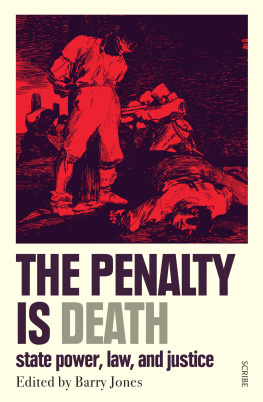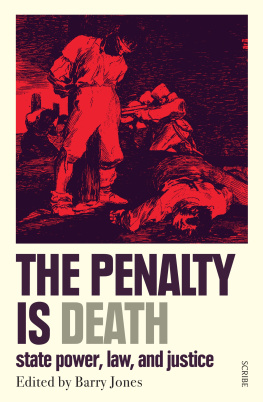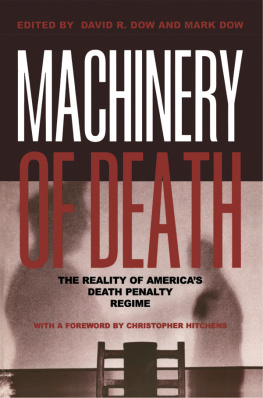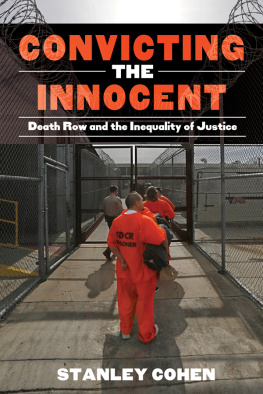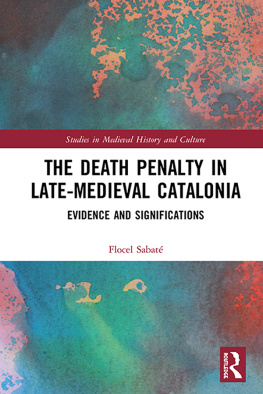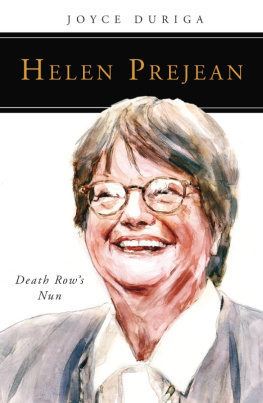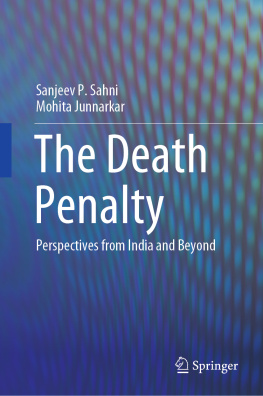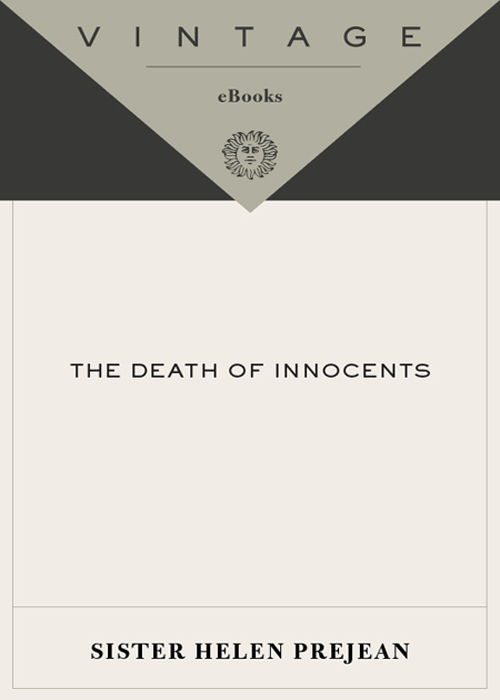
The Death
of Innocents
AN EYEWITNESS ACCOUNT OF WRONGFUL EXECUTIONS
Sister Helen Prejean

RANDOM HOUSE NEW YORK
CONTENTS
To Murder Victims Families for Human Rights, who show us the way
the earthen vessel may hold the rarest wine
the handwrought silver gobletgall
the tattered coverwords of wisdom
the gold-edged leafthe cruelest lie
stumbling wordsloves true oath
the silver tonguea razors edge
the truth arrives disguised,
therein the sorrow lies
JIMMY GLASS
EXECUTED IN LOUISIANA, 1984
Woe to you, scribes.... [You] tie up heavy burdens, hard to bear, and lay them on the shoulders of others; but [you] are unwilling to lift a finger to move them... blind guides! You strain out a gnat but swallow a camel.... [You] have neglected the weightier matters of the law: justice and mercy.
Jesus
ACKNOWLEDGMENTS
I have a lot of people to thank for the birth of this book.
My first thanks go to my friend and editor, Jason Epstein, who helped me shape my first book, Dead Man Walking, and now this book, five years in the making. I cant think of a better wordsmith on this planet than Jason Epstein, and lucky me, he chose to stay on as my editor after he retired from Random House. This book, which weaves together stories and constitutional arguments, presented a special challenge. I cant imagine writing a book without Jason Epstein. My debt of gratitude to him is beyond measure, my affection for him immense.
Special thanks to my literary agent, Gloria Loomis, who provided the life-giving link to Jason Epstein and Random House. Glorias savvy ability as an agent has won my admiration, but her fierce commitment to social justice has won my respect and love. Gloria and Jason and the staff at Random House give me renewed hope that publishers and literary folks care about social justice as much as activist nuns do. I count as a peak experience the moment when, seated around a conference table at Random House, editor in chief Daniel Menaker ended a meeting by announcing: With the publication of Dead Man Walking, we opened the national conversation about the death penalty. With The Death of Innocents, were going to catalyze public discourse that will end the death penalty.
I give heartfelt thanks to senior editor Lee Boudreaux and assistant editor Laura Ford; copy editor Sona Vogel; legal adviser Laura Goldin; production manager Richard Elman; the publicity team, headed by Carol Schneider and assisted by Richard Callison and Sally Marvin; and Gina Centrello, who is giving her wholehearted support to the book. And, of course, my thanks to the enthusiastic sales team, who has pledged to join me on the road to spread this book far and wide.
My heartfelt thanks go to Michael Radelet, who not once, not twice, but three times researched factual content for the myriad endnotes in this book. Mike performed the same painstaking research for Dead Man, but this project gave him triple work because the book kept morphing on me. But Mike grumbled only once about the extra work, a worthy grumble if ever there was one. Mike is a writer himself and a great speaker and teacher.
Richard Dieter, who heads the Death Penalty Information Center, also deserves special thanks. He single-handedly read through Chapter 3, The Machinery of Death, four times, honing the legal arguments and researching court rulings. This chapter bears most of the constitutional arguments, so I needed a lot of help to frame arguments in a way that ordinary folks (like me) can understand.
Im deeply indebted to generous friends who came to my assistance in the final stages of editing: Rose Vines, who coordinated the work of other editors and who holed up in Montana with me for twelve days to do the final push; Lillie Eyrich, who assisted with legal research; Liz Scott Monaghan and Katy Scott (and Art Scott, who cooked for us during an editing session); Lynn Jensen; Tom Dybdahl; Jason DeParle; and Sister Jane Louise Arbour.
Thanks to the host of lawyer friends and technical experts who read the manuscript and offered advice: Nick Trenticosta, Susana Herrero, Paula Montonye, Denise LeBoeuf, Barry Scheck, Stuart James, Millard Farmer, and Jim Marcus. Lori Urs, whose passion for justice is unquenchable, helped me immeasurably with the Joseph ODell narrative. And thanks to Jeff Garis, Jane Henderson, Shari Silberstein, Stephen Zeigler, and Robert Deans, who, on very short notice, researched information.
Great gratitude to all of the people who have provided me with hideaway places to write: the Barker familyDickie and Charlene, Brett and Melissa, Keith and Stacie, Chris and Kari; Jim and Lin Roscoe; Barbara and Karl Fischer; Scottie and Geri Scardina; Joe and Joyce Arnona; and, most especially, Franciscan Sisters Marya Grathwohl and Pat Bietsch, fellow nuns and treasured friends, who give me a writing room at Prayer Lodge on the Northern Cheyenne reservation in Montana. I am also deeply indebted to the Northern Cheyenne people, who teach me their traditions and sustain me with their friendship.
Profound thanks to my special assistants: Sister Margaret Maggio, CSJ, Carolyn Clulee, and Emile Netzhammer, who help me at every turn and who provide prayerful support and encouragement. Final thanks to my sister and brother, Mary Ann and Louis, and my religious community, the Sisters of St. Joseph of Medaille, who give me more love and support than I deserve. If it takes a village to raise a child, it surely takes a community to write a book. Now that the book stands poised to be given to the world, what I feel most deeply is humble gratitude.
PREFACE
As in Dead Man Walking, this is my eyewitness account of accompanying two men to executionbut with one huge difference: I believe that the two men I tell about hereDobie Gillis Williams and Joseph Roger ODellwere innocent. The courts of appeal didnt see it that way. Once the guilty verdicts were pronounced and death sentences imposed, every court in the land put their seal of approval on the death sentences of these two men without once calling for thorough review of their constitutional claims. The tragic truth is that you as a reader of this book have access to truths about forensic evidence, eyewitnesses, and prosecutorial maneuvers that Dobies and Josephs jurors never heard. Not surprisingly, Dobie and Joseph were indigent. Its also no surprise that their defenses at trial were abysmal. In fact, Joseph ODell defended himself.
As of September 2004, 117 wrongfully convicted persons have been released from death row. Citizen Innocence Projects, staffed mainly by college student volunteers, have ferreted out evidence and eyewitnesses that liberated the wrongly accused, sometimes only hours away from execution. Dobie and Joseph were not so lucky. And Imy soul seared from watching state governments kill these menentrust these stories to you. Brace yourself. These stories are going to break your heart. And learning about the court system that allowed the injustices at trial to remain in place might upset you even more.
I used to think that America had the best court system in the world. But now I know differently. Why is it that southern states are (and have always been) the most fervent practitioners of government killing, accounting for over 80 percent of U.S. executions? Why is it that Texas alone accounts for one third of the total number of U.S. executions and, in the latest tally, accounts for fully one half of all state killings in 2004 (as of September 27), while the Northeast, supposedly guided by the same Constitution and Supreme Court guidelines, accounts for only 1 percent of executions? What explains the dramatic regional disparity in the way the death penalty is implemented?
Next page

